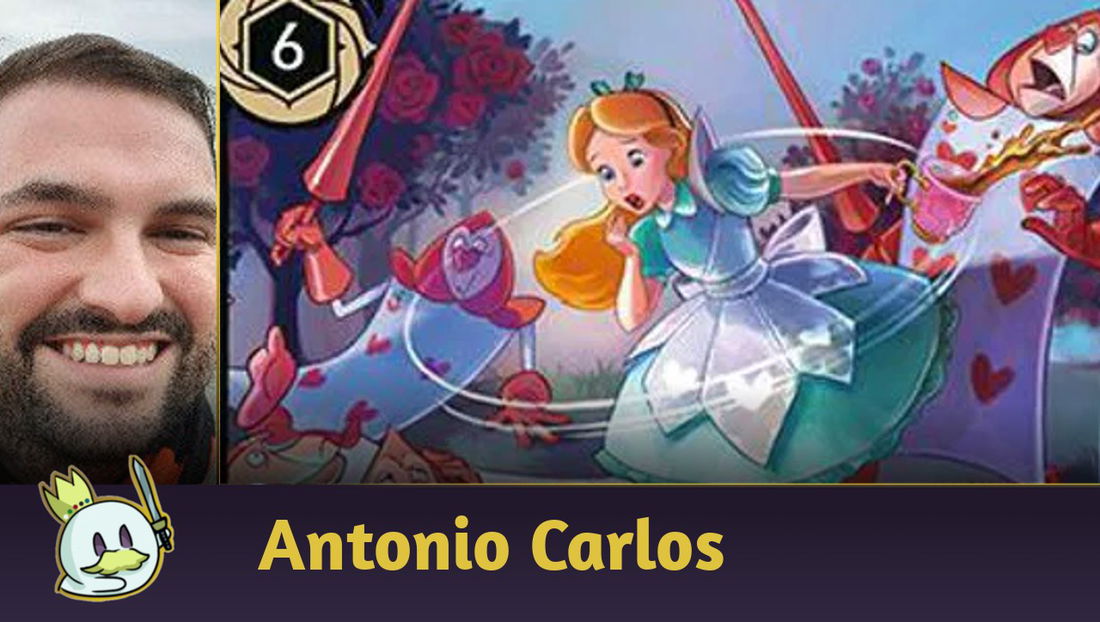Full Speed Ahead!
Hello, everyone!
The recent Lorcana's First World Championship is still fresh in everyone's minds, and today we're going to look at a very interesting and unusual list: Amber-Ruby Aggro, used by Zach Bivens to reach the semifinals of the World Championship. Let's go!
Amber-Ruby Aggro: a new metagame force?
In a previous article, we highlighted that Ruby ink played a fundamental role in deck choices for Worlds. This is because Ruby, competitively speaking, has thrived so far in this metagame only when combined with Sapphire - in a more Control version - or Amethyst - in a more aggro version:
It's no surprise, then, that twenty-five of the twenty-eight World Championship participants brought one of these two combinations among their three decks. Zach Bivens, along with two other participants—Lukas Kaupa, who also finished top eight in the event, and Diego Saz—were the only ones who chose the unusual pair, Amber Ruby, in an extremely fast and aggressive combination:
Bivens reached the semifinals with his decks, and demonstrated the effectiveness of Amber-Ruby in the quarterfinals, winning a game in just a few turns. He was defeated in the semifinals by the eventual champion, Dinh Khang Pham.
Let's analyze the deck's game plan and the role of each card.
The Gameplan
It's worth remembering that at Worlds, an opponent's deck was benched before the match began. Thus, you could stop your opponent from using a more Control-ish deck, and once it was decided who was the starting player, you could opt for Amber-Ruby.
This strategy, strategic and effective, took both Bivens and Kaupa to the Top 8 at Worlds, and Bivens specifically to the Top 4.
The Amber-Ruby deck is an aggressive deck through and through: the plan is to reach 20 Lore as quickly as possible, and ideally, play characters that generate a lot of Lore in the first 2-3 turns, then protect them until victory.
Bivens' list has sixty characters and no other card types—undoubtedly a deck refined for maximum efficiency and not wasting any time durdling with non-Lore cards. Furthermore, thirty-six of them cost one or two ink—more than half the deck! This indicates not only that the deck looks to fill the board in the first few turns, but also that there's no need to increase your inkwell beyond the fourth ink, thus allowing more cards in hand to play.
Deck sequencing is one of the most crucial parts, so let's separate the cards in the list by their ink cost.
1-Drops

The twelve 1-cost characters kick off the deck's aggressive plan, as they all encourage you to seize the initiative in the Lore race.
Daisy Duck and Lilo can easily generate 2 or 4 Lore before the opponent deals with them, giving you not only an early lead in Lore but also a lead in tempo.
Moana is a 1-cost character with very strong stats—to balance it, she can't Challenge unless you have a Captain character in play. The biggest advantage is being able to use her to counter an opponent's threat, but you'll need Piglet —the deck's only Captain.
The other option is to use Moana as a Lore generator that will attract removal from the opponent, or likely banishes the opposing character that challenges her, keeping you at card parity.
2-Drops


In the 2-Drops, we'll have some different roles.
Lilo, Simba, and Piglet are the Lore generators, continuing the plan established by the 1-Drops. They compensate for their Lore efficiency with fragile stats, which brings us precisely to the other 2-Drops:
Jim Dear and The Prince are Bodyguards, the guardian angels of the small Lore generators. Even if they don't last more than a turn, if they can prevent the opponent from removing a character that generates 2+ Lore, its mission accomplished for Bodyguard team!
Lefou, in fact, has a similar role, as it indirectly protects a character, readying them and thus preventing the opponent from dealing with them through Challenge. It can also be combined with Super Goof to generate a lot of Lore in a single turn.
Finally, Mother Gothel is an inkable card that, in a longer game, has great synergy with Rapunzel. This guarantees you'll be able to draw cards even if you don't have any other characters with damage!
3-Drops

At 3-cost, we again have different roles.
Sisu is an efficient Lore generator, and its ability requires good sequencing from the opponent to avoid wasting characters in Duels. Or, if you need a stronger attacker, Sisu can also fulfill this role—and thanks to its high willpower, it can usually survive to generate more Lore in the future.
Lady is one of the most popular cards from the Reign of Jafar set, and rightly so—it potentially puts 5 ink value on the board, while costing only 3! Not only that, it generates 2 Lore on its own, and in a game where your hand doesn't have 1- or 2-cost options to play along with her, it's still an inkable!
Gloyd is an important finisher, especially when your opponent manages to control the board and you're 1 or 2 points short of closing the game. Or, if you and your opponent are in a frantic Lore race, Gloyd can give you the advantage you need to win in the next turn.
4-Drops

Rounding out the deck, the 4-Drops are the best way to refuel when the opponent has been able to deal with the initial threats.
Minnie is a strong bodyguard that severely punishes when the opponent isn't able to deal with her in a single Duel - and with 8 Willpower, it's not exactly easy to remove her from the board in one Challenge.
Rapunzel helps your highest-defense characters stay on the board for another turn - and not only that, she also draws cards in the process, and generates 2 Lore when she Quests! No wonder it's one of the staple cards in the Amber ink.
And to top it all off, Super Goof is an excellent option against other decks with smaller characters, or simply to generate the last Lore points in a match. It synergizes very well with Lefou, as we mentioned before, and with the deck's various bodyguards, you can easily Duel 2 or more times throughout the turns!
Conclusion
Metagame analysis and bench strategy were important factors in choosing this Amber-Ruby deck, but that doesn't mean the deck itself wouldn't succeed otherwise.
The list is extremely effective, and in a more open metagame—possibly even post-rotation!—it could be very successful, especially due to how fast it is.
It was undoubtedly a well-deserved result for Bivens, and it was a delight for the viewers to see such diverse lists make it all the way to the Worlds semifinals!
I hope you enjoyed the analysis! Leave your feedback, suggestions, and questions in the comments below!
Cheers, and see you next time!













— Comments 0
, Reactions 1
Be the first to comment